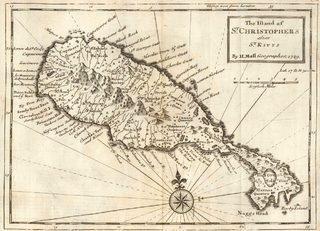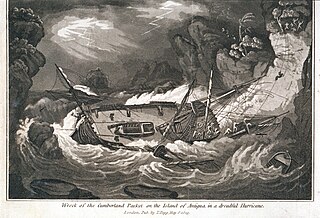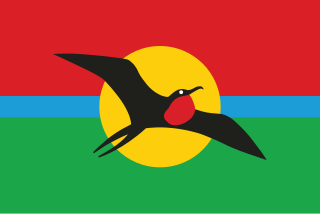
Antigua and Barbuda is a sovereign archipelagic country in the Caribbean. It lies at the conjuncture of the Caribbean Sea and the Atlantic Ocean in the Leeward Islands part of the Lesser Antilles.

Saint Kitts and Nevis have one of the longest written histories in the Caribbean, both islands being among Spain's and England's first colonies in the archipelago. Despite being only two miles apart and quite diminutive in size, Saint Kitts and Nevis were widely recognized as being separate entities with distinct identities until they were forcibly united in the late 19th century.

The history of Antigua and Barbuda covers the period from the arrival of the Archaic peoples thousands of years ago to the present day. Prior to European colonization, the lands encompassing present-day Antigua and Barbuda were inhabited by three successive Amerindian societies. The island was claimed by England, who settled the islands in 1632. Under English/British control, the islands witnessed an influx of both Britons and African slaves migrate to the island. In 1981, the islands were granted independence as the modern state of Antigua and Barbuda.

Barbuda is an island and dependency located in the eastern Caribbean forming part of the twin-island state of Antigua and Barbuda as an autonomous entity. Barbuda is located approximately 30 miles (48 km) north of Antigua. The only settlements on the island are Codrington and its surrounding localities. Barbuda is a flat island with the western portion being dominated by Codrington Lagoon, and the eastern portion being dominated by the elevated plateau of the Barbuda Highlands, with salty ponds and scrubland spread throughout the island. The climate is classified as tropical marine.

The British West Indies (BWI) were the territories in the West Indies under British rule, including Anguilla, the Cayman Islands, the Turks and Caicos Islands, Montserrat, the British Virgin Islands, Bermuda, Antigua and Barbuda, the Bahamas, Barbados, Dominica, Grenada, Jamaica, Saint Kitts and Nevis, Saint Lucia, Saint Vincent and the Grenadines, British Honduras, British Guiana and Trinidad and Tobago.

The music of Antigua and Barbuda is largely African in character, and has only felt a limited influence from European styles due to the population of Antigua and Barbuda descending mostly from West Africans who were made slaves by Europeans.

Antigua, also known as Waladli or Wadadli by the local population, is an island in the Lesser Antilles. It is one of the Leeward Islands in the Caribbean region and the most populous island of the country of Antigua and Barbuda. Antigua and Barbuda became an independent state within the Commonwealth of Nations on 1 November 1981.
Antiguan and Barbudan Creole, is an English-based creole language consisting of several varieties spoken in the Leeward Islands, namely the countries of Antigua and Barbuda, Saint Kitts and Nevis and the British territories of Anguilla and Montserrat.

Lieutenant-Colonel Christopher Codrington was an English Army officer, planter and colonial administrator who served as governor of the Leeward Islands from 1699 to 1704. Born on Barbados into the planter class, he inherited one of the largest sugar plantations in the colony. Codrington travelled to Europe during the late-17th century and served in the Nine Years' War and War of the Spanish Succession, taking part in numerous engagements.

The term British West Indies refers to the former English and British colonies and the present-day overseas territories of the United Kingdom in the Caribbean.

Betty's Hope was a sugarcane plantation in Diamonds, Antigua. It was established in 1650, shortly after the island had become an English colony, and flourished as a successful agricultural industrial enterprise during the centuries of slavery. It was the first large-scale sugar plantation to operate in Antigua and belonged to the Codrington family from 1674 until 1944. Christopher Codrington, later Captain General of the Leeward Islands, acquired the property in 1674 and named it Betty's Hope, after his daughter.

The traditions of West Africa and the United Kingdom have the biggest impact on the culture of Antigua and Barbuda. As a crucial component of its culture, Antigua and Barbuda also has its own creole language.

Afro–Antiguans and Barbudans are Antiguans and Barbudans of entirely or predominantly African ancestry.
Colonel Christopher Codrington was a Barbadian-born planter and colonial administrator who served as the governor of the Leeward Islands from 1689 to 1699.
Antiguan and Barbudan nationality law is regulated by the 1981 Constitution of Antigua and Barbuda, the various Antigua and Barbuda Citizenship Acts, the Millennium Naturalisation Act of 2004, and various British Nationality laws. These laws determine who is, or is eligible to be, a national of Antigua and Barbuda. Antiguan and Barbudan nationality is typically obtained either on the principle of jus soli, i.e. by birth in Antigua and Barbuda; or under the rules of jus sanguinis, i.e. by birth abroad to a parent with Antiguan or Barbudan nationality. It can also be granted to persons with an affiliation to the country, by investment in the country's development, or to a permanent resident who has lived in the country for a given period of time through naturalisation. Nationality establishes one's international identity as a member of a sovereign nation. Though it is not synonymous with citizenship, rights granted under domestic law for domestic purposes, the United Kingdom, and thus the commonwealth, has traditionally used the words interchangeably.

This article covers the history of the Presidency of Antigua from 1871 until 1958. During this period, Antigua was a presidency part of the British Leeward Islands, also including the islands of Barbuda and Redonda. During this era, universal suffrage was established, and local government thrived. In 1958, Antigua joined the West Indies Federation.

This article covers the history of Antigua and Barbuda from the end of the Pre-Columbian period in 1493 to 1687. During this era, the first African slaves were brought to Antigua and Barbuda, and the native population was driven to near-extinction. For much of this period, Antigua and Barbuda was officially known as the Colony of Antigua.

Antigua and Barbuda is mostly of African descent, with Antiguans and Barbudans being classified into seven ethnic divisions as of the last census in 2011. In that census, 81,066 people declared their ethnicity, out of a total population of 86,295. In descending order, the largest ethnic groups are: Africans, other mixed, Hispanic, white, Indian, other, mixed (black/white), and Syrian/Lebanese. All inhabited parishes and dependencies in the country are majority-African.

This article covers the history of Antigua and Barbuda from emancipation in 1833 until the British Leeward Islands were federalized in the early 1870s. During this era, the economy was significantly reformed, and many Afro-Antiguan villages were established. Antigua was often formally called the Colony of Antigua during this period. This is also when Barbuda began to merge with Antigua, and the communal land system was established.
This is a timeline of Antiguan and Barbudan history, consisting of various important political and historical events. To read about the background to these events, see the History of Antigua and Barbuda.












